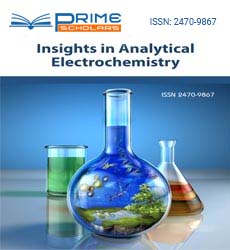Commentary Article - (2023) Volume 9, Issue 3
Current problems and analytical methods in the neuroepigenomics era
Amanda Klassen*
Department of Chemistry, University of New Brunswick, Canada
*Correspondence:
Amanda Klassen,
Department of Chemistry, University of New Brunswick,
Canada,
Email:
Received: 30-Aug-2023, Manuscript No. ipaei-23-18175;
Editor assigned: 01-Sep-2023, Pre QC No. ipaei-23-18175 (PQ);
Reviewed: 15-Sep-2023, QC No. ipaei-23-18175;
Revised: 20-Sep-2023, Manuscript No. ipaei-23-18175 (R);
Published:
27-Sep-2023, DOI: 10.21767/2470-9867-9.3.23
Description
In the realm of analytical chemistry, the landscape is vast and
diverse, with various methodologies illuminating the path to
understanding complex systems. Among these, analytical electrochemical
techniques stand out as powerful tools capable of
unravelling the mysteries hidden within chemical and biological
systems. This commentary delves into the world of analytical
electrochemistry, exploring its significance and potential
applications. Analytical electrochemistry, at its core, harnesses
the relationship between electricity and chemical reactions to
provide valuable insights into the composition and behavior
of substances. Unlike traditional analytical methods, electrochemical
techniques offer a dynamic and real-time approach,
making them particularly suitable for studying dynamic systems.
One of the key advantages of analytical electrochemistry lies
in its ability to probe redox reactions. Redox reactions, involving
the transfer of electrons between species, are fundamental
in various biological and chemical processes. Analytical electrochemical
methods, such as cyclic voltammetry and chronoamperometry,
enable researchers to scrutinize these electron
transfers with high precision. This capability is invaluable in
fields ranging from environmental monitoring to pharmaceutical
development. The versatility of analytical electrochemical
techniques is exemplified by their applications in sensing and
biosensing. Electrochemical sensors, with their ability to detect
and quantify specific analytes, have become indispensable
in fields like healthcare and environmental monitoring. These
sensors capitalize on the selective nature of electrochemical
reactions, providing a reliable means of detecting substances
ranging from glucose levels in blood to pollutants in water.
Furthermore, the marriage of electrochemistry with nanotechnology
has opened new frontiers in analytical chemistry. Nanostructured
materials, such as graphene and carbon nanotubes,
enhance the sensitivity and selectivity of electrochemical sensors.
This synergy has given rise to ultrasensitive detection
methods, pushing the limits of what was once deemed possible
in analytical chemistry. In the pharmaceutical industry,
analytical electrochemistry plays a crucial role in drug development
and quality control. Voltammetric techniques, for instance,
enable researchers to characterize the electrochemical
behavior of pharmaceutical compounds. This insight is vital in
understanding the stability and reactivity of drugs, ensuring
their safety and efficacy.
Analytical electrochemistry is not without its challenges. The
complexity of some systems, coupled with the need for sophisticated
instrumentation, can pose hurdles. However, ongoing
advancements in technology continue to address these challenges,
making electrochemical techniques more accessible
and user-friendly. As we navigate an era of heightened environmental
awareness, analytical electrochemistry emerges as
a beacon of hope. The monitoring of pollutants, both in air
and water, is streamlined by electrochemical sensors that offer
rapid and reliable measurements. The ability to detect trace
amounts of contaminants is pivotal in safeguarding our environment
and public health.
In conclusion, analytical electrochemical techniques stand as
pillars in the edifice of modern analytical chemistry. Their versatility,
coupled with advancements in nanotechnology and
instrumentation, propels them to the forefront of scientific inquiry.
Acknowledgement
None.
Conflict Of Interest
The author’s declared that they have no conflict of interest.
Citation: Klassen A (2023) Current Problems and Analytical Methods in the Neuroepigenomics Era. Insights Anal Electrochem. 9:23.
Copyright: © 2023 Klassen A. This is an open-access article distributed under the terms of the Creative Commons Attribution License, which permits unrestricted use, distribution, and reproduction in any medium, provided the original author and source are credited.

